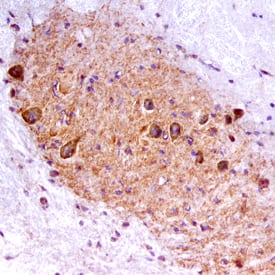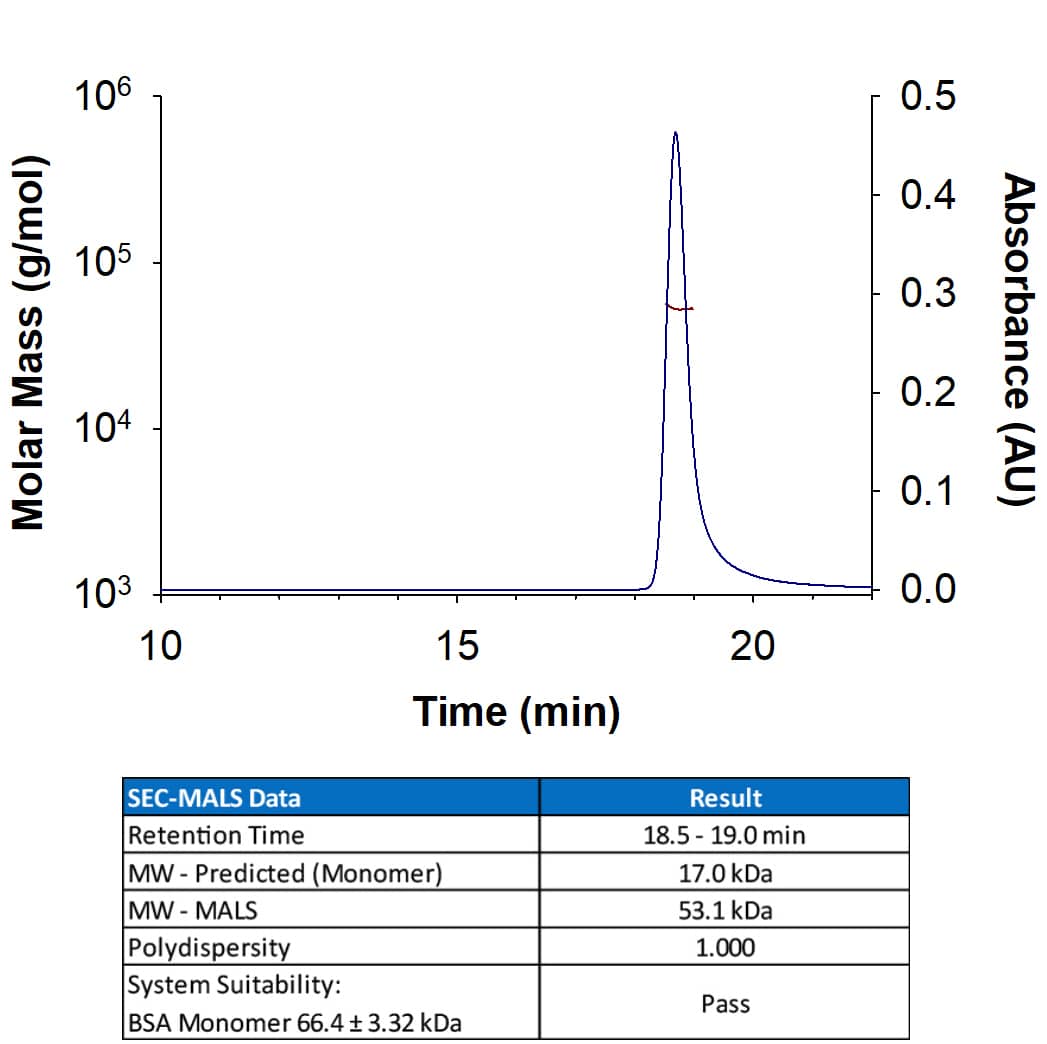Human Ret Antibody Summary
Leu29-Arg635
Accession # P07949
Customers also Viewed
Applications
Please Note: Optimal dilutions should be determined by each laboratory for each application. General Protocols are available in the Technical Information section on our website.
Scientific Data
 View Larger
View Larger
Detection of Ret in SH‑SY5Y Human Cell Line by Flow Cytometry. SH‑SY5Y human neuroblastoma cell line was stained with Mouse Anti-Human Ret Monoclonal Antibody (Catalog # MAB718, filled histogram) or isotype control antibody (Catalog # MAB002, open histogram), followed by Allophycocyanin-conjugated Anti-Mouse IgG F(ab')2Secondary Antibody (Catalog # F0101B). To facilitate intracellular staining, cells were fixed with paraformaldehyde and permeabilized with saponin.
Preparation and Storage
- 12 months from date of receipt, -20 to -70 °C as supplied.
- 1 month, 2 to 8 °C under sterile conditions after reconstitution.
- 6 months, -20 to -70 °C under sterile conditions after reconstitution.
Background: Ret
The GDNF family of neurotrophic factors forms a subfamily within the TGF-beta superfamily. These proteins are potent survival factors for various central and peripheral neurons during development and the adult animal. The GDNF family members (GDNF, neurturin, artemin and persephin) signal through multicomponent receptors that consist of the Ret receptor tyrosine kinase and one of four glycosyl-phosphatidylinositol (GPI)-linked ligand-binding subunits (GFR alpha -1‑4). GFR alpha -1 -2, -3 and -4 are the preferred ligand-binding subunits for GDNF, neurturin, artemin and persephin, respectively. The Ret tyrosine-kinase receptor is encoded by the c-ret proto-oncogene. Mutations of the ret gene have been associated with various human diseases affecting tissues derived from the neural crest, including Hirschsprung’s disease, multiple endocrine neoplasia MEN2A and MEN2B, and familial medullary thyroid carcinoma. Human and mouse Ret share 83% amino acid sequence homology (77% homology in the extracellular domain and 93% homology in the cytoplasmic domain). Although Ret does not bind GDNF ligands directly, the extracellular domain of Ret binds the GDNF-GFR-alpha complex with high affinity and is a potent GDNF antagonist in the presence of soluble GFR-alpha (1‑4).
- Trupp, M. et al. (1998) Mol. Cell. Neurosci. 11:47.
- Enokido, Y. et al. (1998) Curr. Biol. 8:1019.
- Carlomagno, F. et al. (1998) Endocrinology 139:3613.
- Baloh, R. et al. (1998) Neuron 21:1291.
Product Datasheets
Citations for Human Ret Antibody
R&D Systems personnel manually curate a database that contains references using R&D Systems products. The data collected includes not only links to publications in PubMed, but also provides information about sample types, species, and experimental conditions.
4
Citations: Showing 1 - 4
Filter your results:
Filter by:
-
hPSC-derived sacral neural crest enables rescue in a severe model of Hirschsprung's disease
Authors: Y Fan, J Hackland, A Baggiolini, LY Hung, H Zhao, P Zumbo, P Oberst, AP Minotti, E Hergenrede, S Najjar, Z Huang, NM Cruz, A Zhong, M Sidharta, T Zhou, E de Stanchi, D Betel, RM White, M Gershon, KG Margolis, L Studer
Cell Stem Cell, 2023-03-02;30(3):264-282.e9.
Species: Human
Sample Types: Whole Cells
Applications: ICC -
hPSC-derived sacral neural crest enables rescue in a severe model of Hirschsprung's disease
Authors: Y Fan, J Hackland, A Baggiolini, LY Hung, H Zhao, P Zumbo, P Oberst, AP Minotti, E Hergenrede, S Najjar, Z Huang, NM Cruz, A Zhong, M Sidharta, T Zhou, E de Stanchi, D Betel, RM White, M Gershon, KG Margolis, L Studer
Cell Stem Cell, 2023;30(3):264-282.e9.
-
The neurotrophic factor receptor RET drives haematopoietic stem cell survival and function.
Authors: Fonseca-Pereira D, Arroz-Madeira S, Rodrigues-Campos M, Barbosa I, Domingues R, Bento T, Almeida A, Ribeiro H, Potocnik A, Enomoto H, Veiga-Fernandes H
Nature, 2014-07-27;514(7520):98-101.
Species: Mouse
Sample Types: Whole Cells
Applications: ICC -
Glial cell line-derived neurotrophic factor and endothelial cells promote self-renewal of rabbit germ cells with spermatogonial stem cell properties.
Authors: Kubota H, Wu X, Goodyear SM, Avarbock MR, Brinster RL
FASEB J., 2011-04-27;25(0):2604-14.
Species: Rabbit
Sample Types: Whole Cells
Applications: ICC
FAQs
No product specific FAQs exist for this product, however you may
View all Antibody FAQsIsotype Controls
Reconstitution Buffers
Secondary Antibodies
Reviews for Human Ret Antibody
Average Rating: 3 (Based on 2 Reviews)
Have you used Human Ret Antibody?
Submit a review and receive an Amazon gift card.
$25/€18/£15/$25CAN/¥75 Yuan/¥2500 Yen for a review with an image
$10/€7/£6/$10 CAD/¥70 Yuan/¥1110 Yen for a review without an image
Filter by:














